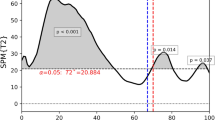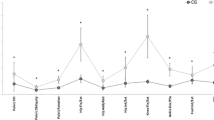Abstract
This study analysed the spatio-temporal parameters, asymmetry, variability and bilateral coordination of gait in women and men with fibromyalgia and healthy subjects walking at their usual velocity and at a faster walking velocity. Fifty-five women and 12 men with fibromyalgia were analysed. A healthy group of 44 women and 17 men was analysed as the control group. A GAITRite system was used to obtain the spatio-temporal gait parameters for the participants when walking at their usual velocity and at a faster velocity. Coefficients of variation, bilateral coordination and gait asymmetry indexes were calculated. All groups exhibited a significant increase (p < 0.001) in spatio-temporal parameters when walking fast. The fibromyalgia groups showed increased bilateral coordination, asymmetry and variability of stance phase when walking fast. The fibromyalgia women showed significant spatio-temporal, variability and bilateral coordination of gait differences compared with the healthy women. The fibromyalgia men reported significant differences in velocity, cadence, stride length, swing time variability and stance gait asymmetry indices compared with the healthy men. No significant differences were observed between the men and women in the fibromyalgia groups. The findings of the present study did not support gender-specific differences in walking variables and indices in FM patients. The differences found between both genders of FM patients and healthy subjects in walking indices at fast velocities could be a useful tool for diagnoses and evaluation of male and female patients with FM during short-term fast walking tests.




Similar content being viewed by others
References
Wolfe F (1990) Diagnosis of fibromyalgia: the new criteria. J Musculoskel Med 7:53–69
Smith H, Harris R, Clauw D (2011) Fibromyalgia: an afferent processing disorder leading to a complex pain generalized syndrome. Pain Physician 14:E217–E245
Marques AP, Santo ASE, Berssaneti AA, Matsutani LA, SLK Y (2017) Prevalence of fibromyalgia: literature review update. Rev Bras Reumatol Eng Ed 57:356–363. https://doi.org/10.1016/j.rbre.2017.01.005
Mas A, Carmona L, Valverde M, Ribas B (2008) Prevalence and impact of fibromyalgia on function and quality of life in individuals from the general population: results from a nationwide study in Spain. Clin Exp Rheumatol 26:519–526
Lawrence RC, Felson DT, Helmick CG, Arnold LM, Choi H, Deyo RA, Gabriel S, Hirsch R, Hochberg MC, Hunder GG, Jordan JM, Katz JN, Kremers HM, Wolfe F, National Arthritis Data Workgroup (2008) Estimates of the prevalence of arthritis and other rheumatic conditions in the United States: part II. Arthritis Rheumatol 58:26–35
Wolfe F, Ross K, Anderson J, Russell I (1995) Aspects of fibromyalgia in the general population: sex, pain threshold, and fibromyalgia symptoms. J Rheumatol 22:151–156
Yunus M, Celiker R, Aldag J (2004) Fibromyalgia in men: comparison of psychological features with women. J Rheumatol 31:2464–2467
Miro E, Martinez M, Sanchez A et al (2015) Men and women with fibromyalgia: relation between attentional function and clinical symptoms. Br J Heal Psychol 20:632–647. https://doi.org/10.1111/bjhp.12128
Yunus M, Inanici F, Aldag J, RF M (2000) Fibromyalgia in men: comparison of clinical features with women. J Rheumatol 27:489–490
Lange M, Karpinski N, Krohn-Grimberghe B, Petermann F (2010) Patients with fibromyalgia: gender differences. Schmerz 24:262–266. https://doi.org/10.1007/s00482-010-0924-0
Buskila D, Neumann L, Alhoashle A, Abu-Shakra M (2000) Fibromyalgia syndrome in men. Semin Arthritis Rheum 30:47–51
Ruiz-Perez I, Ubago-Linares M, Bermejo-Perez M et al (2007) Differences in sociodemographic, clinical, psychosocial and health care characteristics between men and women diagnosed with fibromyalgia. Rev Clin Esp 207:433–439
Häuser W, Kühn-Becker H, von Wilmoswky H, Settan M, Brähler E, Petzke F (2011) Demographic and clinical features of patients with fibromyalgia syndrome of different settings: a gender comparison. Gend Med 8:116–125. https://doi.org/10.1016/j.genm.2011.03.002
Sanchez A, Valenza M, Martınez M et al (2013) Gender differences in pain experience and physical activity of fibromyalgia patients. J Musculoskelet Pain 21:147–155. https://doi.org/10.3109/10582452.2013.796036
Segura-Jiménez V, Estévez-López F, Soriano-Maldonado A, Álvarez-Gallardo IC, Delgado-Fernández M, Ruiz JR, Aparicio VA (2016) Gender differences in symptoms, health-related quality of life, sleep quality, mental health, cognitive performance, pain-cognition, and positive health in Spanish fibromyalgia individuals: the Al-Ándalus project. Pain Res Manag 2016:1–14. https://doi.org/10.1155/2016/5135176
Auvinet B, Chaleil D, Cabane J, Dumolard A, Hatron P, Juvin R, Lanteri-Minet M, Mainguy Y, Negre-Pages L, Pillard F, Riviere D, Maugars YM (2011) The interest of gait markers in the identification of subgroups among fibromyalgia patients. BMC Musculoskelet Disord 12:258. https://doi.org/10.1186/1471-2474-12-258
Auvinet B, Bileckot R, Alix A et al (2006) Gait disorders in patients with fibromyalgia. Joint Bone Spine 73:543–546
Heredia Jiménez JM, Aparicio García-Molina VA, Porres Foulquie JM, Delgado Fernández M, Soto Hermoso VM (2009) Spatial-temporal parameters of gait in women with fibromyalgia. Clin Rheumatol 28:595–598. https://doi.org/10.1007/s10067-009-1101-7
Pierrynowski M, Tiidus P, Galea V (2005) Women with fibromyalgia walk with an altered muscle synergy. Gait Posture 22:210–218
Goes S, Leite N, de Souza R et al (2014) Gait characteristics of women with fibromyalgia: a premature aging pattern. Rev Bras Reum 54:335–341. https://doi.org/10.1016/j.rbr.2013.11.003
Heredia-Jimenez JM, Soto-Hermoso VM (2014) Kinematics gait disorder in men with fibromyalgia. Rheumatol Int 34:63–65. https://doi.org/10.1007/s00296-012-2651-6
Sadeghi H, Allard P, Prince F, Labelle H (2000) Symmetry and limb dominance in able-bodied gait: a review. Gait Posture 12:34–45
Patterson KK, Gage WH, Brooks D, Black SE, McIlroy WE (2010) Evaluation of gait symmetry after stroke: a comparison of current methods and recommendations for standardization. Gait Posture 31:241–246. https://doi.org/10.1016/j.gaitpost.2009.10.014
Plotnik M, Giladi N, Hausdorff JM (2007) A new measure for quantifying the bilateral coordination of human gait: effects of aging and Parkinson’s disease. Exp Brain Res 181:561–570. https://doi.org/10.1007/s00221-007-0955-7
Yogev G, Plotnik M, Peretz C, Giladi N, Hausdorff JM (2007) Gait asymmetry in patients with Parkinson’s disease and elderly fallers: when does the bilateral coordination of gait require attention? Exp Brain Res 177:336–346. https://doi.org/10.1007/s00221-006-0676-3
Heredia-Jimenez J, Orantes-Gonzalez E, Soto-Hermoso V (2016) Variability of gait, bilateral coordination, and asymmetry in women with fibromyalgia. Gait Posture 45:41–44. https://doi.org/10.1016/j.gaitpost.2016.01.008
Kressig RW, Beauchet O, Gaitrite E, Group N (2005) Guidelines for clinical applications of spatio-temporal gait analysis in older adults. Aging Clin Exp Res 18:174–176. https://doi.org/10.1007/BF03327437
Hof AL, Elzinga H, Grimmius W, Halbertsma JPK (2002) Speed dependence of averaged EMG profiles in walking. Gait Posture 16:78–86. https://doi.org/10.1016/S0966-6362(01)00206-5
Zifchock R, Davis I, Higginson J, Royer T (2008) The symmetry angle: a novel, robust method of quantifying asymmetry. Gait Posture 27:622–627
Andriacchi TP, Ogle JA, Galante JO (1977) Walking speed as a basis for normal and abnormal gait measurements. J Biomech 10:261–268. https://doi.org/10.1016/0021-9290(77)90049-5
Heredia-Jimenez J, Latorre-Roman P, Santos-Campos M, Orantes-Gonzalez E, Soto-Hermoso VM (2016) Spatio-temporal gait disorder and gait fatigue index in a six-minute walk test in women with fibromyalgia. Clin Biomech 33:1–6. https://doi.org/10.1016/j.clinbiomech.2016.01.009
Brach J, Studenski S, Perera S et al (2008) Stance time and step width variability have unique contributing impairments in older persons. Gait Posture 27:431–439
Brach J, Studenski S, Perera S et al (2007) Gait variability and the risk of incident mobility disability. J Gerontol Med Sci 62A:983–988
O’Connor SM, Xu HZ, Kuo AD (2012) Energetic cost of walking with increased step variability. Gait Posture 36:102–107. https://doi.org/10.1016/j.gaitpost.2012.01.014
Ortega J, Farley C (2007) Individual limb work does not explain the greater metabolic cost of walking in elderly adults. J Appl Physiol 102:2266–2273
Goldenberg D, Mossey C, Schmid C (1995) A model to assess severity and impact of fibromyalgia. J Rheumatol 22:2313–2318
Prados G, Miró E, Pilar-Martínez M et al (2013) Fibromyalgia: gender differences and sleep-disordered breathing. Clin Exp Rheumatol 6:S102–SS10
Hooten W, Townsend C, Decker P (2007) Gender differences among patients with fibromyalgia undergoing multidisciplinary pain rehabilitation. Pain Med 8:624–632
Aparicio V, Ortega F, Carbonell-Baeza A et al (2012) Are there gender differences in quality of life and symptomatology between fibromyalgia patients? Am J Mens Health 6:314–319. https://doi.org/10.1177/1557988312436872
Acknowledgments
The work of Orantes-González, E was supported by the Ministry of Education, Culture and Sports of Spain (ref. FPU13/00162, EST15/00019).
The research programme of the Faculty of Education, Economy & Technology of Ceuta, to support the editing of the manuscript was acknowledged.
Author information
Authors and Affiliations
Corresponding author
Ethics declarations
Disclosures
None.
Rights and permissions
About this article
Cite this article
Heredia-Jimenez, J., Orantes-Gonzalez, E. Gender differences in patients with fibromyalgia: a gait analysis. Clin Rheumatol 38, 513–522 (2019). https://doi.org/10.1007/s10067-018-4293-x
Received:
Revised:
Accepted:
Published:
Issue Date:
DOI: https://doi.org/10.1007/s10067-018-4293-x




